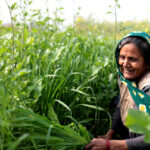Food environments: Do we know enough?
As a researcher, I was always inquisitive to tease out the relationship between things. During my PhD days, I spent three years in a rural community of Haryana. I had to interview 612 families with one child as an index participant for the research study. This allowed me to understand the complexity and intertwining relationships of rural life and its domains in depth. Having a specialization in food and nutrition, I was assessing diet consumption at an individual level, availability at the household; food markets (community), and school level. During this entire journey, I realized that food is an emotion that connects people in the food environment surrounding individuals.
Food environments are created by human-built and social environments. They are the physical, social, economic, cultural, and political factors that impact the accessibility, availability, and adequacy of food within a community or region. Food environments may be defined in terms of geographic access to food in a community or neighborhood, consumer experiences inside food outlets, services and infrastructure in institutional settings, or the information available about food. In the last 2 decades, the understanding and definition of the food environment have rapidly evolved. Recent efforts are to describe the food environment in a more comprehensive manner to encompass diverse variables that link people’s food acquisition and consumption within the wider food system.
Food environments can also bridge the transitioning food choices developed over the course of a lifetime and the complex food systems of different geographies. Rapid changes in food environments, living conditions, and the global nutritional transition are considered primary drivers of both undernutrition and overnutrition, although these are traditionally addressed as two distinct silos (Hawkes et al, 2020). It is in this context, that the creation of a healthy food environment as a multi-sectoral nutritional intervention action has been emphasised or tackled in light of the current nutrition reality (WHO, 2019).
The food environments in LMICs have been identified as dynamic and complex, with more variability, changing seasonality, a lack of coherent data on various dimensions of food environments, and a diverse range of food sources. But do we have enough to understand the complex and contextual food environment surrounding us? There is a need for methods and matrices for a deeper understanding of socio-ecological interactions with food acquisition, dietary and health outcomes in LMICs (Turner et al, 2018).
For understanding these interactions, there is a need for different factors of the food environment that interplay in a socio-ecological theory framework at multiple levels, including individual, household, neighbourhood food markets, school level, and policy level, influencing dietary outcomes in LMICs. The major finding from the review is that all the factors identified as part of these levels do not function in silos and interact with each other across the levels to influence the dietary outcome of an individual.
Research studies have shown that the dietary outcome of an individual changes according to the characteristics of the neighbourhood surrounding the immediate food environment at both the interpersonal and intrapersonal levels. There is a need to restructure the wet markets or small shops or open-air markets or specialized markets or street markets, or retail format of markets in the neighbourhood to provide availability and accessibility to healthy, affordable eating.
There is a need for school-level policies for regulating the sale of unhealthy food items inside and outside schools and to create an environment for providing the availability of affordable healthy eating to schoolchildren. The sudden and unexpected transition in the food systems of developing countries has resulted in the retail revolution and changed the food supply chain. These have resulted in the increased availability of nutrient-poor foods being regularly consumed by very young children in LMICs, resulting in all forms of malnutrition. This shift in the food value chain is having profound effects on the diets of all LMICs and subsequently affecting both undernutrition and overnutrition (Hawkes et al, 2019). There is a need for understanding local and context-specific measures of food environments for policy influence and health benefits at the population level.




